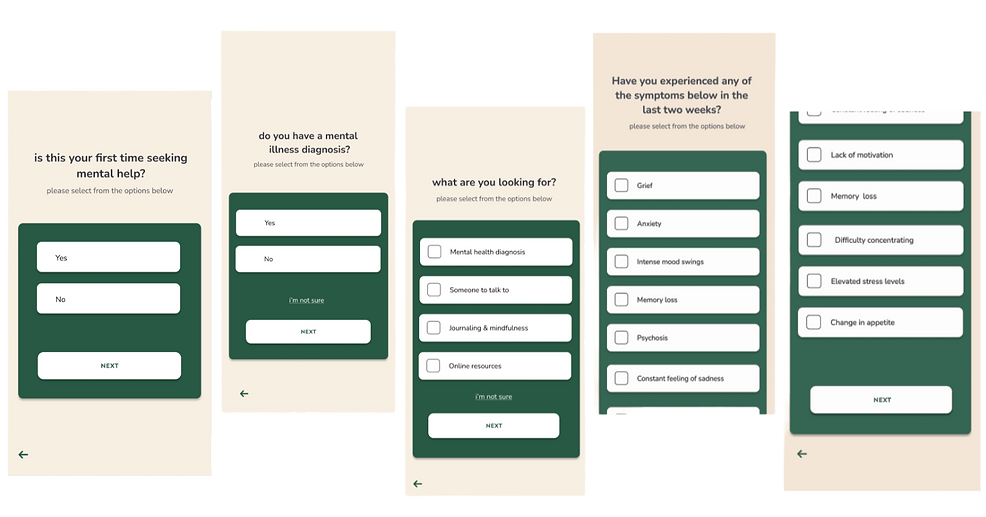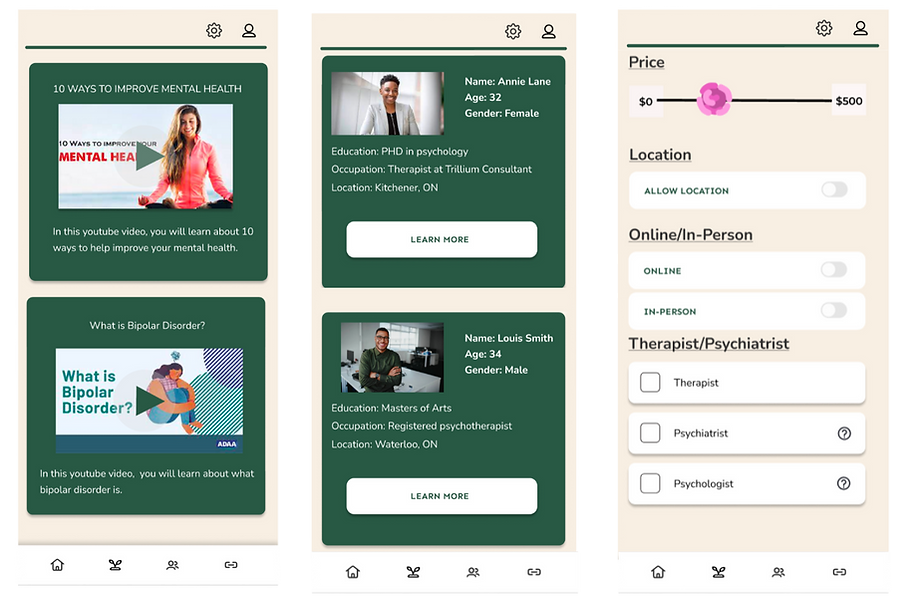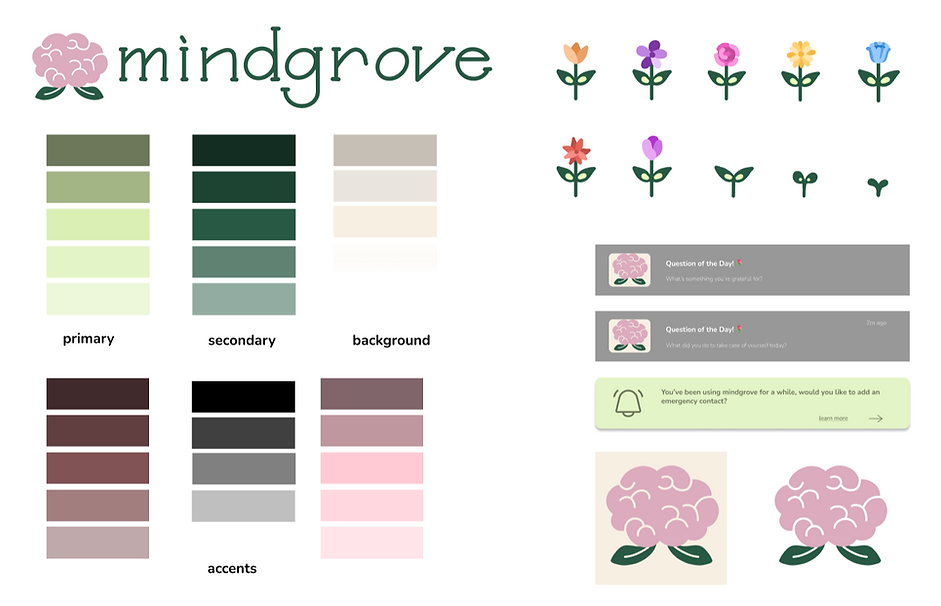Designing To De-stigmatize Design Jam
Mindgrove
Team: Jenani Yoganathan, Amy Jaikissoon, Nikaash Kulkarni, Gurmehak Kaur, Anya Jain & Anika Srinivasan
Role: Innovator and Product Designer
Timeline: 6 hours
.png)
The Problem and Challenge

Mental health challenges affect many Canadians, leaving some unable to find the resources or specialists they need, while others remain unaware of where to seek help. Half of Canadians who meet the diagnostic criteria for a mood or anxiety disorder have not spoken to a mental health practitioner in the past year.
For the Design Jam challenge, my team was tasked with creating an empathetic and inclusive solution to connect at-risk Canadians with publicly available mental health support. Our goal was to educate users about available services and empower them to take charge of their mental well-being.
We had just 6 hours to complete this design challenge, and through collaboration, we created Mindgrove, a solution designed to address this critical issue.
To begin the challenge, our team brainstormed ideas and solutions to address the problem. We decided to create a mobile application as it is more accessible and easier to navigate than a website. Once we finalized the platform, we narrowed down our brainstormed ideas and identified five essential features that we believed were key to solving the problem effectively.

Ideation Process
The initial step in the ideation process involved crafting a comprehensive questionnaire aimed at pinpointing the specific needs of the user. This questionnaire delved into various aspects, including inquiries about mental illness diagnoses, symptoms experienced, and the user's specific requirements or preferences. By systematically gathering this information, we aimed to gain a thorough understanding of the user's situation, enabling us to tailor our subsequent ideation efforts to address their unique needs effectively.
.png)
Following that, I conceptualized an "Explore" page to provide users with access to a diverse array of resources aimed at educating them about various mental illnesses. These resources included videos, helplines, and articles, all personalized to the user’s specific preferences and needs, as determined through a questionnaire.
As a team, we then discussed and explored the idea of incorporating a feature to suggest therapists, counsellors, and mentors available in the user’s area. This feature would offer a curated list of professionals, tailored to different expertise levels, locations, and pricing options, ensuring accessible and relevant support for every user.
.png)
Lastly, one of the key features we aimed to integrate into the app was gamification, designed to incentivize users to engage continuously. This gamification element was seamlessly integrated with three core features: the wellness journal, mood tracker, and sleep tracker.
Through these features, users are encouraged to reflect on and express their emotions. Upon completing all three tasks, users are rewarded with a virtual flower that is then added to their digital garden. The concept of nurturing a virtual flower was proposed to instill a sense of self-care and responsibility in users.
Additionally, we proposed the inclusion of an emergency contact feature. If the app detects concerning changes in the user's mood, sleep patterns, or activity levels, it will first notify the user and provide relevant resources. If the situation persists, users will be prompted to reach out to their designated emergency contact. Both parties must consent to information sharing, and users can opt out of this feature at any time. In essence, Mindgrove is more than just an app; it's an application designed to help users cultivate both tier virtual gardens as well as their minds.
.png)
Mindgrove's Visual Documentation
Below, you'll find a visual representation of our finalized brand, showcasing our brand icons, vibrant colour palette, and captivating logo design. These vibrant colours and dynamic logos are crafted to embody the essence of our brand, symbolizing the deep connection between the mind and growth. Our logo, blends the intricate form of a brain with the delicate beauty of a flower, creating a unique and captivating symbol. It also showcases our app's core concept of nurturing mental well-being for personal development. The rich hues of pink and green serve as our primary and secondary colours, each carefully chosen to evoke feelings of positivity, tranquillity, and life. To the right, you'll discover a glimpse of our app's user interface, showcasing sample notifications and the delightful flower icons that are used in our virtual garden. These charming flowers not only beautify the app but also serve as interactive elements, enhancing the user experience and fostering engagement with mindfulness activities.

Once we solidified our key features, established our theme, and selected our colour palette, we turned to design tools like Figma and Adobe Illustrator to create our mobile application's high-fidelity prototype. Take a journey through our presentation by clicking through the slider to explore each feature's detailed prototype. There is also a button below that will take you directly to the Figma file for a closer look at the designs.
Key Takeaways
Collaboration Under Time Constraints 🕰️
Working on this project in a high-pressure, 6-hour timeframe was an incredible learning experience. It required us to quickly establish a shared understanding of the problem and divide responsibilities efficiently. Clear communication became critical, ensuring everyone stayed aligned while tackling different aspects of the solution. I learned the value of leveraging each team member's unique strengths to contribute to a cohesive design. For example, some teammates focused on crafting the visual identity, while others concentrated on feature functionality. By trusting the process and maintaining a collaborative mindset, we were able to ideate, design, and present a polished concept within the limited time frame. This reinforced the importance of adaptability and teamwork in dynamic environments.
Empathy-Driven Design 💜
Designing for mental health challenged me to think deeply about the user’s perspective and the sensitivities around the topic. It was essential to craft a solution that felt not only functional but also compassionate and inclusive. We prioritized understanding the challenges faced by users through research and discussions, which guided every design decision. Creating features like the "Explore" page, curated resources, and emergency contact functionality emphasized the importance of fostering trust and safety in the user experience. I realized that addressing such a delicate issue requires a balance between offering practical tools and cultivating a sense of empowerment and care for the user.
.png)






